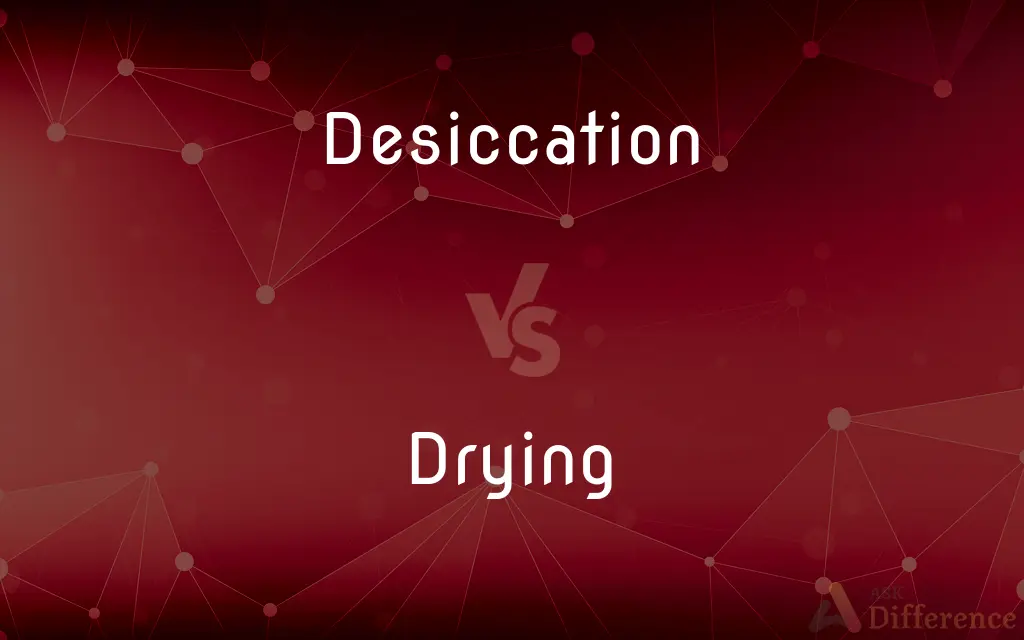Desiccation vs. Drying — What's the Difference?
Edited by Tayyaba Rehman — By Urooj Arif — Updated on April 3, 2024
Desiccation involves removing moisture to preserve or dry something, typically for biological or chemical purposes, while drying is a broader term for removing liquid to achieve a drier state.

Difference Between Desiccation and Drying
Table of Contents
ADVERTISEMENT
Key Differences
Desiccation is a process specifically aimed at removing moisture from materials, often to preserve biological specimens or in chemical synthesis, where the removal of water is crucial to maintain the stability of the product or to prevent reactions. On the other hand, drying is a more general term that refers to the process of removing liquid from an object or substance, which can be done for a variety of reasons, such as drying clothes after washing or drying paint after application.
While desiccation often involves techniques that remove water to a very low level, sometimes using specialized equipment like desiccators or lyophilizers to achieve an extremely dry state, drying might not always achieve such low levels of moisture and can be achieved through natural processes like evaporation or with the help of simple tools like a hairdryer or an oven.
Desiccation is critical in laboratories and scientific research for preparing and preserving samples. This ensures that the biological material or chemical compound remains unchanged over time, whereas drying can be a routine, everyday task with the primary aim of removing moisture for practical purposes, such as preventing mold growth on wet surfaces or preparing food for cooking.
In the context of food preservation, desiccation is used to significantly reduce the water content of food, effectively inhibiting the growth of microorganisms and enzymes that cause spoilage. Drying, in this context, may refer to simpler methods of removing moisture, such as air drying or sun drying, which are less controlled but still reduce the risk of spoilage.
Comparison Chart
Definition
Removing moisture specifically to preserve or dry for specific needs
General process of removing liquid to achieve a drier state
ADVERTISEMENT
Purpose
Preserve biological specimens, prevent chemical reactions
Remove moisture for practical purposes, prevent spoilage
Equipment
Desiccators, lyophilizers
Ovens, air blowers, natural evaporation
Application Fields
Laboratories, scientific research
Everyday tasks, food preparation, laundry
Moisture Level Achieved
Very low, precise control required
Can vary, not always as low or controlled
Compare with Definitions
Desiccation
Preservation Method.
Desiccation is used to preserve biological samples for long-term storage.
Drying
Routine Task.
Drying dishes after washing is a routine household task to prevent water spots.
Desiccation
Scientific Research.
Scientists use desiccation to dry chemicals, ensuring reactions occur without moisture interference.
Drying
General Process.
Drying clothes outside is a common practice to remove moisture.
Desiccation
Controlled Environment.
Desiccation often requires a controlled environment to achieve the desired dryness.
Drying
No Special Equipment.
Drying can be achieved with simple tools like a hairdryer or naturally by air.
Desiccation
Specialized Equipment.
Desiccators and lyophilizers are commonly used for desiccation in laboratories.
Drying
Various Applications.
Drying is essential in painting to ensure the paint adheres properly.
Desiccation
Low Moisture Content.
Desiccation aims to achieve extremely low moisture levels in materials.
Drying
Variable Moisture Levels.
Drying food involves removing enough moisture to prevent spoilage but not all moisture.
Desiccation
Desiccation (from Latin de- "thoroughly" + siccare "to dry") is the state of extreme dryness, or the process of extreme drying. A desiccant is a hygroscopic (attracts and holds water) substance that induces or sustains such a state in its local vicinity in a moderately sealed container.
Drying
Drying is a mass transfer process consisting of the removal of water or another solvent by evaporation from a solid, semi-solid or liquid. This process is often used as a final production step before selling or packaging products.
Desiccation
To dry out thoroughly.
Drying
Free from liquid or moisture
Changed to dry clothes.
Desiccation
To preserve (foods) by removing the moisture.
Drying
Having or characterized by little or no rain
A dry climate.
Desiccation
To make dry, dull, or lifeless
"Stalinism desiccated the grassroots of urban government" (Timothy J. Colton).
Drying
Marked by the absence of natural or normal moisture
A dry month.
Desiccation
To become dry; dry out.
Drying
Not under water
Dry land.
Desiccation
Lacking spirit or animation; arid
"There was only the sun-bruised and desiccate feeling in his mind" (J.R. Salamanca).
Drying
Having all the water or liquid drained away, evaporated, or exhausted
A dry river.
Desiccation
(uncountable) The state or process of being desiccated
Drying
No longer yielding liquid, especially milk
A dry cow.
Desiccation
An act or occurrence of desiccating
Drying
Not producing a liquid substance that is normally produced
Dry heaves.
Desiccation
The act of desiccating, or the state of being desiccated.
Drying
Not shedding tears
Dry sobs.
Desiccation
Dryness resulting from the removal of water
Drying
Needing moisture or drink
A dry mouth.
Desiccation
The process of extracting moisture
Drying
No longer wet
The paint is dry.
Drying
Of or relating to solid rather than liquid substances or commodities
Dry weight.
Drying
Not sweet as a result of the decomposition of sugar during fermentation. Used of wines.
Drying
Having a large proportion of strong liquor to other ingredients
A dry martini.
Drying
Eaten or served without butter, gravy, or other garnish
Dry toast.
Dry meat.
Drying
Having no adornment or coloration; plain
The dry facts.
Drying
Devoid of bias or personal concern
Presented a dry critique.
Drying
Lacking tenderness, warmth, or involvement; severe
The actor gave a dry reading of the lines.
Drying
Matter-of-fact or indifferent in manner
Rattled off the facts in a dry mechanical tone.
Drying
Wearisome; dull
A dry lecture filled with trivial details.
Drying
Humorous in an understated or unemotional way
Dry wit.
Drying
Prohibiting or opposed to the sale or consumption of alcoholic beverages
A dry county.
Drying
Unproductive of the expected results
A mind dry of new ideas.
Drying
Constructed without mortar or cement
Dry masonry.
Drying
To remove the moisture from; make dry
Laundry dried by the sun.
Drying
To preserve (meat or other foods, for example) by extracting the moisture.
Drying
To become dry
The sheets dried quickly in the sun.
Drying
A prohibitionist.
Drying
Present participle of dry
Drying
The act of drying.
Drying
A method of food preservation by removing water.
Drying
Adapted or tending to exhaust moisture; as, a drying wind or day; a drying room.
Drying
Having the quality of rapidly becoming dry.
Common Curiosities
How does desiccation differ from drying?
Desiccation is more specific and aims for very low moisture levels for preservation, whereas drying is a general term for moisture removal.
What is desiccation?
Desiccation is the process of removing moisture to preserve or prepare materials, often using specialized equipment.
Can desiccation be considered a form of drying?
Yes, desiccation is a specific, controlled form of drying aimed at achieving very low moisture levels.
What does drying mean?
Drying refers to the broad process of removing liquid from an object or substance for various purposes.
Can food be desiccated?
Yes, food can be desiccated to significantly reduce moisture and prevent spoilage.
What equipment is used for desiccation?
Equipment like desiccators and lyophilizers are used for desiccation.
Is drying always achieved with equipment?
No, drying can occur naturally, like air drying, or with simple tools like a hairdryer.
How do desiccation techniques vary?
Techniques vary based on the material's sensitivity and the desired moisture level.
Why is desiccation important in scientific research?
It prevents chemical reactions and preserves biological samples by removing moisture.
What are common uses of drying in everyday life?
Drying is used in laundry, dishwashing, food preparation, and more.
What is the purpose of drying clothes?
The purpose is to remove moisture after washing, making them wearable again.
What does drying paint involve?
Drying paint involves evaporating the solvent or water to leave a solid film.
Is desiccation necessary for food preservation?
Desiccation can be used for long-term food preservation by inhibiting microorganism growth.
Can all materials be desiccated?
Most materials can be desiccated, but the method must be appropriate to avoid damage.
Does drying affect the quality of materials?
Improper drying can affect quality, but proper methods preserve or improve material quality.
Share Your Discovery

Previous Comparison
Southeast vs. Southwest
Next Comparison
Cackle vs. HackleAuthor Spotlight
Written by
Urooj ArifUrooj is a skilled content writer at Ask Difference, known for her exceptional ability to simplify complex topics into engaging and informative content. With a passion for research and a flair for clear, concise writing, she consistently delivers articles that resonate with our diverse audience.
Edited by
Tayyaba RehmanTayyaba Rehman is a distinguished writer, currently serving as a primary contributor to askdifference.com. As a researcher in semantics and etymology, Tayyaba's passion for the complexity of languages and their distinctions has found a perfect home on the platform. Tayyaba delves into the intricacies of language, distinguishing between commonly confused words and phrases, thereby providing clarity for readers worldwide.
















































